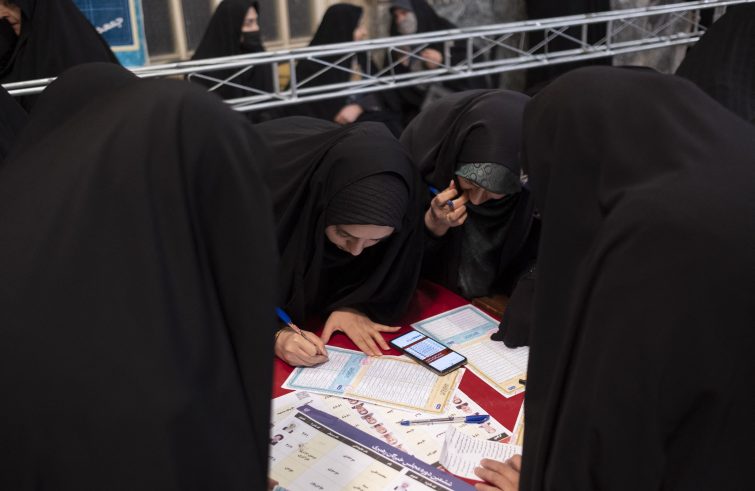
A 41% turnout is the most striking result of the election on 1st March for the renewal of the Islamic Consultative Assembly and the Assembly of Experts. The counting of ballots will determine the final results, albeit with no surprises in store, given that the Guardian Council has barred certain candidates from running in order to determine the outcome of the vote.
It would appear that the turnout decline feared by the leaders of the Islamic Republic has been avoided, considering that surveys abroad had projected that 75% of eligible voters would not show up at the polling stations. True, the authorities delayed the closing of the polls by six hours to encourage voting. Considering that the turnout for the 2020 parliamentary elections was 42%, this figure is a confirmation, in spite of the protests sparked by the death of the Kurdish-Iranian student Mahsa Amini in 2022, stifled by crackdowns and weakened by the disparate demands that stopped them. Still, this is an all-time low, after a 62% turnout in the penultimate parliamentary elections of 2016.
The 285 seats in the Majlis (the remaining 5 seats are reserved for religious minorities: Jews, Zoroastrian Christians, Assyrian Christians, Chaldeans and Armenians) will reflect the existing proportions. Whether elected in single-member districts with run-off elections or in multi-member districts with as many votes as there are seats, they will recreate the Iranian principlist majority that has outnumbered reformists and moderate centrists for the past four years, with 227 seats.
The principlist camp, which has several affiliates, is made up of clerical traditionalists and ultra-conservatives. In addition, there are secular conservatives belonging to the ‘divergent current’ who want to break away from the overt interference of the ayatollahs.
Former president Mahmoud Ahmadinejad, the initiator of the nuclear programme and Khamenei’s former heir apparent, was once in their orbit. He fell out of Supreme Leader Ali Khamenei’s favour because of his socially oriented views and the offices he gave to women in an attempt to assert his independence from the clerics, united by the vilayat-e faqih doctrine on the role of the theologian-jurists, the guardians of the Hidden Imam.
The Guardians’ selection criteria were also applied to the detriment of the “deviant current”: 6 theologians and 6 jurists – respectively appointed by the Supreme Leader and proposed by the Supreme Court – reduced the number of candidates eligible for the Majlis from 49,000 to 15,000. However, the sanctions mainly affected the reformist camp, which complained about the arbitrary enforcement of the disqualification criteria, which included failure to prove Muslim religious affiliation, poor health, insufficient literacy, drug addiction, bad reputation and large land holdings.
The Guardians’ control was all the more acute in the case of the Assembly of Experts, whose task it is to nominate and revoke the Supreme Leader. A total of 136 candidates were admitted to run for 88 seats, which are allocated every eight years by a single round of voting.
In several districts, the ratio resulted in a single candidate. This was the case in Khorasan, where Raisi, the incumbent president, was a candidate. The most prominent outsiders include the centrist candidate Hassan Rouhani, his predecessor, despite having been a member of the Assembly for 20 years and a close friend of Khamenei. This suggests that there is an attempt to set the tone for the election of the third Rahbar, after Khomeini and 84-year-old Khamenei, at a critical juncture that requires mediation between the theocratic centralism represented by the clerics and the new secular ruling class that has emerged from the universities, the high administration and the armed forces.
Overall, the preliminary poll results herald the freezing of the pendulum between the principlists and the reformists. Most important, however, is how this 41% will be interpreted.
Appeals to increase voter participation have been as emphatic as ever, countering the appeals for electoral boycott. The reason is clear, as the military leadership and Khamenei himself have made explicit: it is necessary to vote in order to confirm the popular support for the Islamic Republic and to disappoint the enemies, identified as the Zionists, the US, various European governments and the predatory multinationals lurking on the doorstep. This means resisting the temptation to orchestrate manoeuvres against national security from the outside, hoping for dormant fifth columns and internal agitators. Widening our gaze to the regional scenario, it means not encouraging an escalation in Syria, Lebanon, Yemen and Iraq in the run-up to the White House succession, and counting the times Netanyahu has tried in the past to raise the stakes in Tehran by pulling the strings of his generals.
If the glass is seen as ‘half empty’, the encirclement syndrome could be intensified, with the aim of preventing what has already been foreshadowed, thus strengthening, if possible, the axis of resistance with the regional allies. However, this does not rule out the possibility of cooperation with Saudi Arabia, which, although a competitor, does not want to see the storm in the Middle East intensify. Especially since Iran’s destabilisation could contaminate the oil monarchies with a new “spring wind”.
The attempt to revitalise domestic legitimacy will not entail concessions regarding civil rights. But it could address the economic causes of discontent linked to Western sanctions.
This would accelerate the BRICS process by turning to Moscow and Beijing as vital sources of funding for development plans and key social policies. It would also take advantage of the opportunity to establish Iranian industry as a permanent third-party arms producer. In this way Iran would share the ‘profit-driven rearmament’ formula that today unites the Global Contenders cohorts.
(*) Pontifical Lateran University












